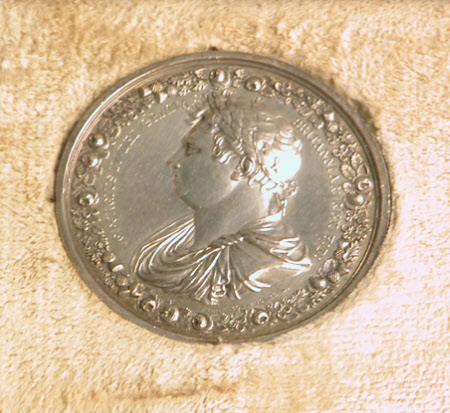Coronation Medal of King George IV
William Wyon (1795 - 1851)
Category
Coins and medals
Date
1821
Materials
Silver
Measurements
53.7 mm (Diameter)
Place of origin
Birmingham
Order this imageCollection
Anglesey Abbey, Cambridgeshire
NT 517662.1
Summary
Silver, George IV (1762-1830), Thomason and Jones (Edward Thomason,1769-1849), 1821. A silver medal published by Messrs Thomason and Jones in 1821 to commemorate the Coronation of King George IV, which took place on 19 July 1821. The obverse shows a bust of the King facing left, dressed as a Roman emperor, in a toga and wearing a wreath. Within a border of roses, thistles and shamrocks, inside which is the legend, translated as ‘George IV by the Grace of God King of Britain, Defender of the Faith’. On the reverse is the king seated on a throne, holding the orb and sceptre, being crowned by three allegorical female figures representing Britannia, Scotia and Hibernia [Ireland]. The legend translates as ‘He administers that which he has already experienced ‘ (i.e. as Regent) and the date of the Coronation. Mounted in a frame with ten other medals and tokens commemorating and celebrating King George IV (1762-1830, reigned 1820-30) (NT 517662).
Full description
After ten years as Prince Regent, George IV finally acceded to the throne of the United Kingdom and Ireland in 1820, at the age of 57. George’s early popularity had long been forfeited as a result of his dissolute and extravagant lifestyle, as well as his treatment of his consort Queen Caroline. Caroline returned from the Continent for the Coronation, but was deliberately excluded from the ceremony by her estranged husband; she died just two weeks later, on 7 August, claiming that she had been poisoned. The Coronation ceremony, held in Westminster Abbey on 19 July 1821, was notable for its magnificence and extravagance. The ceremony in the Abbey lasted five hours and at several points the King seemed to be on the point of fainting, as a result of the heat and the great weight of his robes. It was followed by a banquet in Westminster Hall for 300 guests, at which the medieval ceremony of the Entry of the King’s Champion was enacted for the last time at any coronation of a British monarch (see NT 517662.5). In the account of the Coronation in the Gentleman’s Magazine, it is stated that ‘The Treasurer of His Majesty’s Household threw about the medals of the Coronation’; these were probably the official medal made by Benedetto Pistrucci, examples of which in gold, silver and bronze are among the group of medals of George IV at Anglesey Abbey (NT 517662.3, 571662.6, 517662.7). The present medal was published by Thomason and Jones, but is unsigned. The design was claimed as the work of the medallist William Wyon by his biographer Nicolas Carlyle, who noted that the medal was ‘executed hastily’ and that ‘The Artist, being dissatisfied with this Medal, did not put his name to it.’ Jeremy Warren, 2020
Provenance
Bequeathed to the National Trust by Huttleston Rogers Broughton, 1st Lord Fairhaven (1896-1966) with the house and the rest of the contents in 1966.
Credit line
National Trust Collections (Anglesey Abbey, The Fairhaven Collection)
Marks and inscriptions
Obverse: Legend: GEORGIUS IV DEI GRATIA/BRITANNIAR: REX F: D: Publishers’ signature, below bust: THOMASON & JONES D. Reverse: Legend: ANTE PROBATA MINISTRAT In exergue: CORON: XIX JUL: A: D:/ MDCCCXXI Publishers’ signature, by shield at right: THOMASON & JONES D.
Makers and roles
William Wyon (1795 - 1851), designer Thomason and Jones, publisher
References
Carlyle 1837: Nicholas Carlyle, A Memoir of the Life and Works of William Wyon, London 1837, p. 196 Brown 1980: Laurence Brown, A catalogue of British historical medals 1760-1960, Vol.I. The accession of George III to the death of William IV, London 1980, p. 268, no.1091 Eimer 2010: Christopher Eimer, British Commemorative Medals and their Values, London 2010, p. 160, no. 1143
